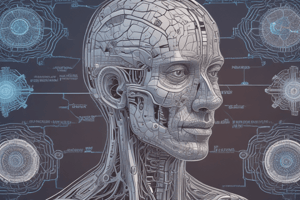Podcast
Questions and Answers
What is the definition of a stroke?
What is the definition of a stroke?
- A temporary loss of consciousness due to low blood pressure
- A gradual increase in blood pressure leading to cerebral hemorrhage
- A sudden neurologic event of vascular origin (correct)
- A sudden collapse of the cardiovascular system
Which structure is crucial in understanding cerebral circulation?
Which structure is crucial in understanding cerebral circulation?
- Carotid artery
- Cerebellum
- Medulla oblongata
- Circle of Willis (correct)
What term refers to a temporary neurologic event that resolves itself within a short period?
What term refers to a temporary neurologic event that resolves itself within a short period?
- Ischemic stroke
- Stroke
- Cerebral hemorrhage
- Transient Ischaemic Attack (correct)
Which of the following is NOT considered a risk factor for stroke?
Which of the following is NOT considered a risk factor for stroke?
What is the primary goal of early treatment in stroke management?
What is the primary goal of early treatment in stroke management?
Flashcards
Stroke
Stroke
A sudden neurological event caused by a blood vessel issue in the brain.
Circle of Willis
Circle of Willis
Network of arteries supplying blood to the brain.
Transient Ischemic Attack (TIA)
Transient Ischemic Attack (TIA)
Temporary disruption of blood flow to the brain.
Stroke causes (young/old)
Stroke causes (young/old)
Signup and view all the flashcards
Stroke prevention
Stroke prevention
Signup and view all the flashcards
Stroke investigation
Stroke investigation
Signup and view all the flashcards
Stroke management
Stroke management
Signup and view all the flashcards
Stroke Unit
Stroke Unit
Signup and view all the flashcards
Stroke advances
Stroke advances
Signup and view all the flashcards
Thrombolysis
Thrombolysis
Signup and view all the flashcards
Study Notes
Stroke Overview
- Stroke is a sudden neurological event of vascular origin.
- Stroke is classified into different types:
- Acute Ischemic Stroke (65%+):
- Infarction (thrombo-embolic)
- Haemorrhage (12%):
- Subarachnoid haemorrhage (6.6%)
- Intracerebral haemorrhage (5.1%)
- Transient Ischemic Attack (21%)
- Acute Ischemic Stroke (65%+):
Learning Objectives
- Define "stroke."
- Describe the Circle of Willis and extracranial cerebral circulation.
- Understand Transient Ischaemic Attack (TIA).
- Know causes and types of stroke in different age groups.
- Understand stroke prevention, including risk factors.
- Understand principles of acute stroke investigation and management.
- Understand the natural history of acute stroke.
Stroke Risk Factors
- Vessel Wall:
- Hypertension
- Smoking
- Atherosclerosis
- Hyperlipidaemia
- Diabetes
- Vessel Lumen:
- Embolism (Heart disease, impaired cardiac function, CHD, AFib, LVH by ECG, valvular disease)
- Thrombosis (Haematococrit, Fibrinogen)
- Other (Race, family history, oral contraceptives, obesity)
Young Stroke (<50)
- All above factors apply
- Additional factors include:
- Vessel Wall Disease:
- Large vessel: fibromuscular dysplasia, dissection
- Small vessel: migraine, vasculitis, drug-induced conditions, sickle cell anaemia, anti-phospholipid syndrome
- Heart: Congenital heart disease and complications (valve prolapse, patent foramen ovale)
- Vessel Wall Disease:
Cerebral Autoregulation
- Cerebral blood flow (CBF): Ischemia thresholds
- Vasodilation occurs.
- CBV in metabolically active tissue = isodense swelling.
Blood Supply to Brain
- Middle cerebral artery (MCA)
- Anterior cerebral artery
- Posterior cerebral artery
- Anterior choroidal artery
- Posterior communicating artery
Collateral Blood Supply
- Good collateral: silent occlusion, infarct extent reduced
- No collateral: massive infarction
- Collateral blocked: propagating thrombus (massive infarction)
Thrombolysis & Clot Retrieval
- Time is brain:
- < 1.5 hours: 1:4 patients
- 1.5 – 3.0 hours: 1:7 patients
- 3.0 – 4.5 hours: 1:14 patients
Endovascular Treatment
- Techniques and procedures used to deal with strokes.
- Rapid endovascular treatment assessment of ischemic stroke.
Small Vessel Disease
- Perforating vessels: end arteries, no collateral, no pressure reduction
- Critical areas: present brain stem(s), design fault. Conditions like Charcot-Bouchard aneurysm
- Lacunar infarction: small infarct but devastating consequences by location
Intracerebral Haemorrhage
- Causes:
- Hypertension
- Amyloid
- Coagulation deficits
- Aneurysm (AVM)
- Cavernoma
- Tumour
- Drugs (therapeutic & recreational)
- Trauma
- Unknown (family history)
- Special Considerations:
- Cerebellum and Neurosurgeon
- Venous sinuses
- Summary
- Hypertension
- Small vascular malformation (AVM)
- Sympathomimetic drugs (cocaine/amphetamines)
- Cerebral amyloid angiopathy (see lecture)
- Anticoagulants + other bleeding disorders
Subarachnoid Haemorrhage
- Association: Polycystic kidneys
- Causes:
- Berry (saccular) aneurysm (congenital defect, progressive enlargement)
- Risk factors: cigarettes, hypertension
- Outcome:
- Death
- Coma or alert
- Survival - rebleed (4-8 days)
- Death
- Diagnosis:
- Worst headache in life
- Neck stiffness
- Xanthochromia (yellowing of CSF)
Studying That Suits You
Use AI to generate personalized quizzes and flashcards to suit your learning preferences.




